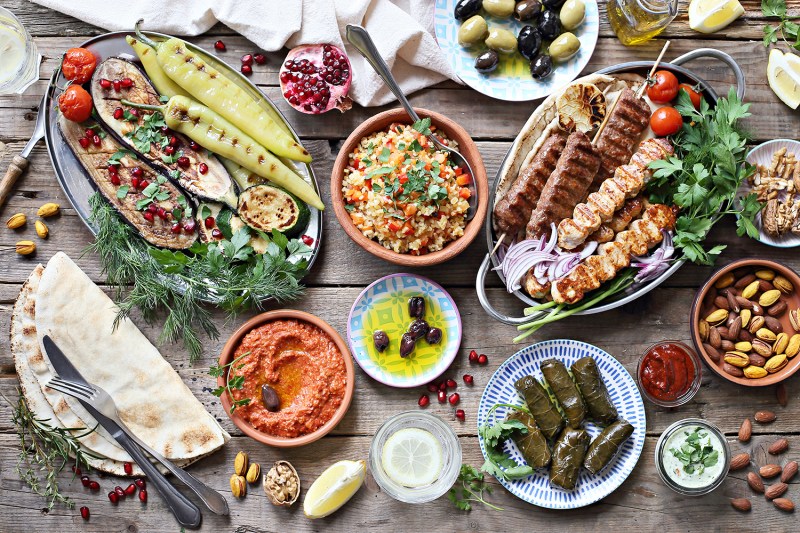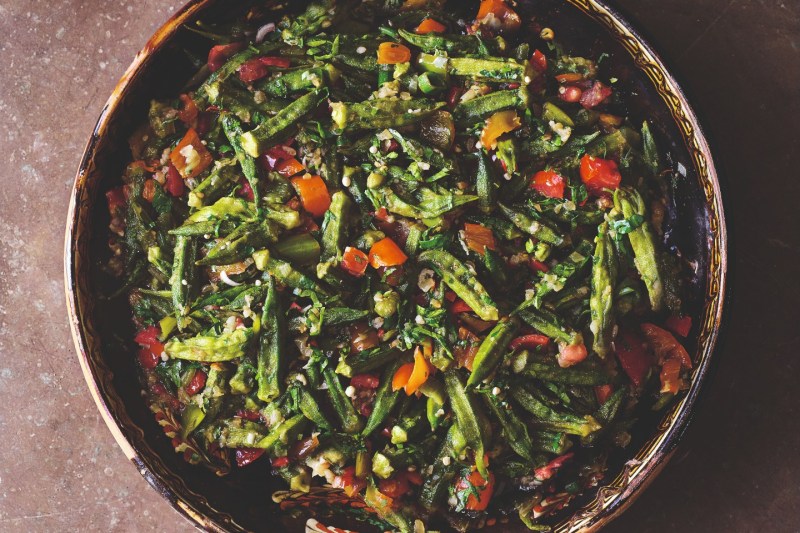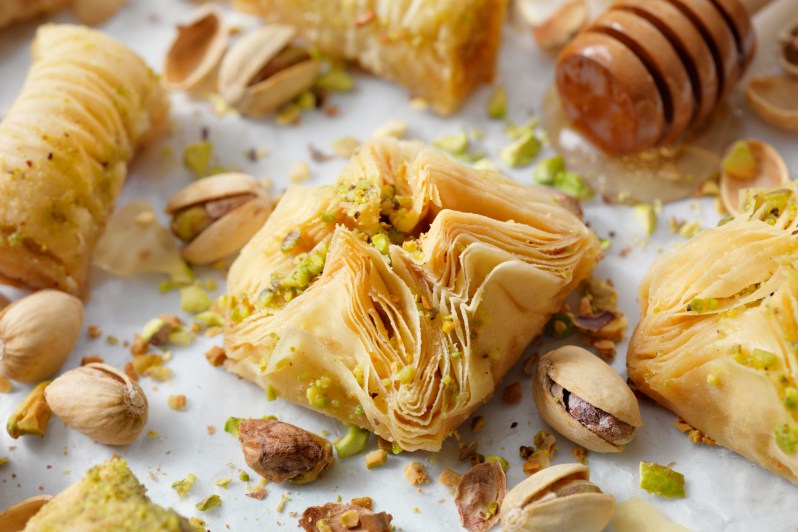
The food culture of Lebanon is rich and resonant, reflecting both its Mediterranean setting and deep anthropological history.
Even those who have never trekked to Beirut — let alone their local Middle Eastern eatery — are likely familiar with a few of the staples. Lebanon, once a major part of the Ottoman Empire, is the birthplace of earthy dishes like baba ganoush and sweet treats such as baklava.
With its admiration for seasonality and a mix of breads and produce almost always accompanied by beverages, Lebanese cuisine is like the Italy of the Arab world. Whether you’re munching at a cafe in Tripoli or just thumbing though a good cookbook at home, this kind of food is not only delicious and distinctive, but it welcomes an unhurried pace over the duration of many, many enjoyable courses.
The history of Lebanese cuisine
Lebanon’s culinary tradition is shaped by multiple factors that have unfolded over thousands of years in the Eastern Mediterranean, otherwise known as the Levant. The country has seen its share of foreign rulers, from Egyptians and Persians to the Romans and even the French. Lebanon was not an independent country until 1943, and the lasting legacy of international oversight has rubbed off on its culinary ways.
What ended up on the table was an ever-evolving mix of longstanding customs and new dishes offered by the powers that be. The Ottomans introduced Lebanon to lamb, while the French prescribed pastries like flan and croissants. Meanwhile, core dishes like flatbread, hummus, and various riffs on shawarma persisted as the backdrop of Lebanon’s decidedly eclectic table.
The regions of Lebanese cuisine
Keep in mind that Lebanon is quite small, around two-thirds the size of Connecticut. But that doesn’t mean there isn’t regionality associated with its cooking. Much of the country resides along the Mediterranean coast, meaning ample seafood options and a warm climate that’s inviting for olive trees and fruit orchards alike.
Inland, it’s quite mountainous, full of foothills, peaks, and fertile lowland valleys. Here, you’ll find a lot of the livestock and produce that goes into the culinary scene. Generally, the southern stretch of the country is synonymous with kibbeh, a classic and comforting dish made from beef, bulgur wheat, pine nuts, mint leaves, and other spices. The northern part is more widely known for its sweets, while meat pastries are very popular in the agricultural eastern wing of Lebanon.
Core dishes

Frankly, there are too many fantastic Lebanese dishes to mention here. But there are some core creations we’d be remiss not to bring up. This is the Mediterranean, so olive oil is king. It’s slathered on fresh produce and breads and applied to poultry, beef, and lamb before grilling.
As you ease into a meal, you’re likely to begin with some mezze. Think of it as the Lebanese version of tapas. These small plates usually include staple salads like fattoush or tabouli and baba ganoush, flatbread, and pickled vegetables. There might also be sarma or stuffed grape leaves, marinated seafood, and some form of fried chickpeas.
Entrees generally consist of hearty options like stews, otherwise known as yakhneh. Bean stews are popular, as are those made with okra and tomatoes. Another stew fixture is mulukhiyah, made from chicken, beef, and mallow leaves and dressed with vinegar and raw diced onions. Manaeesh is like Arab pizza, a light dough hit with meat, herbs, and cheese. Vegetarian options are also immensely popular, like moussaka, a mix of fried eggplant and chickpeas in an onion and tomato sauce.
Lebanese cuisine in America
Most major cities tout at least a handful of solid Lebanese or Lebanese-inspired options. You get at least a taste of this at regional Middle Eastern joints and markets and, with a little digging, can find an even clearer example of Lebanese food.
There are classic spots like Hayat’s Kitchen in Los Angeles and a plethora in places like suburban Detroit, where many Lebanese have emigrated to. Places like Dearborn, Michigan, are about a third Arab, paving the way for area institutions like Al Ameer.
“I love the natural basic ingredients we use in our cuisine. The organic olive oil, fresh herbs like thyme, basil, mint, and parsley,” said Hilda Dibe, second-generation owner of Nicholas in Portland. “We source most of our ingredients locally and import certain items from Lebanon like our tahini.”
Dibe said her tabouli best demonstrates the Lebanese palate, full of freshness thanks to Italian parsley, mint, quinoa, tomatoes, olive oil, and just-squeezed lemon juice. There’s a hospitality angle, too, something she picked up from her dad and the restaurant’s namesake. Dibe told us that he considered his restaurant his house and would greet diners with complimentary Turkish coffee and conversation at the end of meals. Nicholas was known to greet farmers and shop owners with his tabouli and hummus every time he was out collecting ingredients.
Another important aspect that Americans are getting to enjoy more of is the country’s wine. Our collective and ever-curious palate is taking us to faraway wine hotspots like Israel, Georgia, and Lebanon. While the national drink is Akra, an anise-based spirit, there’s a flourishing wine scene in Lebanon that was popularized in the 1970s but is technically one of the oldest on the planet.
Dibe likes the work of Chateau Ksara from the Bekaa Valley, especially with kebabs.
“The chardonnay especially complements the garlic found in the kebab marinade,” she said. “The wine is grown at altitude and fermented and aged “sur lie” [on the lees] in new oak. It is full-bodied, complex, fresh and creamy with citrus, stone fruit, and savory notes.”
Okra in lemon-cilantro sauce

From the cookbook The Arabesque Table by Reem Kassis, this recipe holds a Lebanese lens up to a Middle Eastern vegetable dish. As Kassis said, it’s inspired by the Lebanese custom of finishing a stew with cilantro and fried garlic. “This okra dish works perfectly as part of a mezze, as a side to meats, or even as a simple vegetarian meal served with bread,” Kassis told The Manual.
Method
- Preheat the oven to 450 degrees Fahrenheit.
- Wash the okra, pat dry, and trim away the stem ends.
- In a bowl, toss the okra with 2 tablespoons of olive oil and 1/2 teaspoon of salt. Arrange on a sheet pan in a single layer.
- Roast in the oven, tossing periodically until the okra starts to brown and blister in parts and develops a nice seared aroma, 15-20 minutes. Remove from the oven and set aside.
- In a large frying pan, heat the remaining 4 tablespoons of olive oil over medium heat. Add the garlic, chili, and remaining 1/2 teaspoon salt. Cook until fragrant but not browned, 2-4 minutes. Add tomato (if using), cilantro, and chili flakes and cook for another minute.
- Tip in the roasted okra, tossing evenly to combine, then pour in the lemon juice along with 2 tablespoons of water. Give one final stir, then remove from heat and serve.
Lebanese-style lamb kabobs

This recipe comes courtesy of Nicholas Restaurant, a small chain of three Lebanese and Mediterranean restaurants in Portland dating back to 1986. Here, mint is used to ease the flavor of the lamb and freshen up some of the gamey flavors.
Ingredients
- 2.5 pounds of lamb legs cut into 1 1/2-inch cubes
- 2 teaspoons salt
- 2 teaspoons black pepper
- 1 teaspoon cinnamon
- 1 teaspoon allspice
- 1/2 teaspoon ground cloves
- 1 teaspoon cumin
- 1/2 teaspoon coriander
- 1/2 teaspoon nutmeg
- 1 cup of finely chopped mint
- 1/4 cup extra-virgin olive oil
Method
- Mix all the ingredients together with the meat and let marinate for 2 hours
- After marinating, find 12-inch skewers and soak in water.
- Then skewer about four pieces in each skewer and separate each lamb piece with your favorite veggies (mushrooms, red, green or yellow peppers, red onions, zucchini, yellow squash, eggplant, etc.).
Desserts and sweets of the Lebanese cuisine

We very quickly mentioned sweets in Lebanese cuisine above, so let’s get your mouth watering and go into more detail about desserts in Lebanese food. Here are a few popular ones.
- Baklava: We mentioned this one, but what exactly is it? This well-known pastry is made with layers of phyllo dough filled with nuts (often pistachios or walnuts) and sweetened with syrup or honey. The Lebanese version is often flavored with rose or orange blossom water.
- Knafeh: This rich and cheesy dessert is made with shredded phyllo dough, soaked in syrup, and topped with melted cheese. It’s often enjoyed hot.
- Maamoul: These Lebanese sweets are shortbread cookies stuffed with dates, nuts, or figs. They’re a popular dessert served during holidays and special occasions.
- Namoura: This is a semolina cake soaked in syrup (do you see a pattern here?), making it very sweet and sticky. Many eat it with nuts or coconut.
- Sfouf: Another cake dessert, this one is made with semolina and turmeric, which gives it a yellow color. It can be flavored with nuts, sesame paste, or aniseed.



